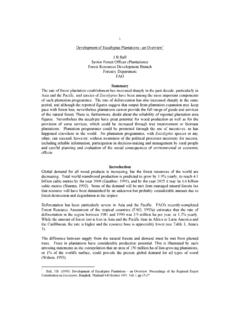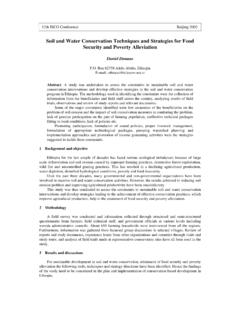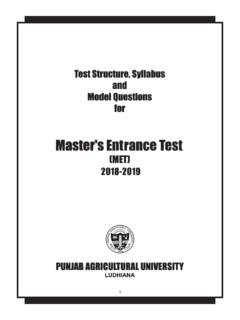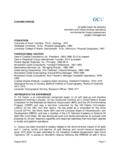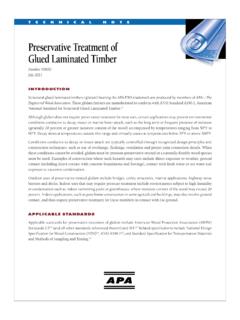Transcription of Assessing the quality of forest fuel loading data ...
1 CSIRO PUBLISHING. International Journal of Wildland Fire 2014, 23, 585 590. Research Note Assessing the quality of forest fuel loading data collected using public participation methods and smartphones Colin J. Ferster A,B and Nicholas C. Coops A. A. Department of forest Resources Management, Faculty of Forestry, University of British Columbia, 2424 Main Mall, Vancouver, BC, V6T 1Z4, Canada. B. Corresponding author. Email: Abstract. Effective wildfire management in the wildland urban interface (WUI) depends on timely data on forest fuel loading to inform management decisions. Mobile personal communication devices, such as smartphones , present new opportunities to collect data in the WUI, using sensors within the device such as the camera, global positioning system (GPS), accelerometer, compass, data storage and networked data transfer. In addition to providing a tool for forest professionals, smartphones can also facilitate engaging other members of the community in forest management as they are now available to a growing proportion of the general population.
2 Approaches where the public participates in the data- collection process (inspired by citizen science) may be beneficial for fire hazard issues. This research note demonstrates a smartphone application for measuring forest fuel loading in the WUI by forestry professionals and non-professionals, and evaluates the quality of the collected data. smartphones and their associated applications may provide new tools for collecting forest structural data in the WUI, but forest managers need to ensure that measurement protocols provide the required precision for analysis and enforce the logical consistency of observations made by a diverse set of data collectors, and that sufficient training is provided. If these recommendations are followed, we conclude that data acquired by volunteers in collaborative projects through smartphone applications can be of acceptable quality to help inform forest management decisions. Additional keywords: citizen science, geographic information systems, remote sensing, spatial information.
3 Received 12 October 2013, accepted 4 February 2014, published online 9 April 2014. Introduction photographs allowing field crews to visually match observed In many wildland urban interface (WUI) areas, fire is a natu- site conditions with the photos and record the corresponding rally occurring event. In recent years, policies of fire exclusion quantitative values for fuel loading (Maxwell and Ward 1976). have led to changes in forest structure, including an accumula- Another method is the photoload technique, where synthetic fuel tion of fuels. This, in turn, has led to more severe wildfires, beds with known fuel loadings are photographed (downward which in combination with more people living in the WUI, and oblique), also creating a visual guide for assessment (Keane necessitates the management of wildfire hazards (Radeloff et al. and Dickinson 2007). Sikkink and Keane (2008) compared rapid 2005). Activities such as fuels modification and reduction are assessment techniques with traditional direct measurements, performed with the aim of reducing the intensity and severity of such as planar intersect and fixed area plots, and found that wildfires near priority areas, such as communities (Agee and there are trade-offs between the methods in terms of measure- Skinner 2005).
4 Challenges in prescribing treatments include that ment accuracy, experience and time required to complete each (1) forest fuels are spatially variable and can change rapidly due assessment. All of these methods lay a solid foundation for new to storm windfall, or other natural changes in forest structure and approaches that may be advanced by technology. (2) measuring forest structural components under dense cano- Recent advances in communication technology, including pies is difficult using remote sensing approaches, due to sensor smartphones , have led to new opportunities for collecting data. geometry. Therefore, accurate characterisation of forest fuels A growing proportion of the population use smartphones with depends on frequent measurement by field crews (Keane et al. Internet connectivity to widely and rapidly share information. 2001). Data collected about forest fuel loading are an important These devices are generally less expensive than electronic input into forest management software, including applied geo- devices that are purpose-built for forestry and they provide graphic information systems (GIS) and fire behaviour models to opportunities to easily install applications; deliver instructions plan, prioritise, design and implement fuels treatments and fire and enter data on a touch screen interface; acquire images using suppression strategies (Ohlson et al.)
5 2003; Lutes et al. 2006). the camera; measure location and direction using the global Several methods for the rapid assessment of forest fuels positioning system (GPS) and compass; measure angles using an have been developed. The photo series technique involves accelerometer; store data and transmit it over a network. These measuring fuels in reference plots and taking oblique reference devices also have the potential to collect forest structural data to Journal compilation IAWF 2014 586 Int. J. Wildland Fire C. J. Ferster and N. C. Coops compliment Earth observation data collected by satellite remote visual assessment techniques such as photo series and photoload sensing devices (Ferster and Coops 2013). Several previous (Sikkink and Keane 2008). Each participant was assigned a projects have utilised smartphones to collect Earth observation random, non-personally identifying code, which was recorded data ( Powell et al. 2012; Weng et al.
6 2012; Pratihast et al. and linked to the volunteered plot data and reference data. The 2013b; and others including several commercial offerings). assessment included three parts (Fig. 1). First, a series of slides Approaches for collecting data using smartphones can introduced the general concepts of forest fuels management. draw guidance from public participation in scientific research Second, visual estimations of the quantity and arrangement of (PPSR), also known as citizen science. In PPSR, people without fuels on site were made using diagrams and illustrations for explicit scientific training may take part in the research process, reference and, for each component, the closest matching cate- often leading to personal advances for the participants, occa- gory was selected using menus and buttons. The categories and sional scientific breakthroughs and potentially more effective definitions followed the regional protocol in British Columbia resource management (Shirk et al.
7 2012). There are numerous (see Morrow et al. 2008) (Table 1), making the results com- incentives for utilising PPSR-inspired approaches for wildfire patible with previous datasets. Third, participants acquired management. Many people have smartphones , providing the location information from the GPS, slope, aspect and images potential to collect data covering broad areas (Lane et al. 2010). of the fuel loading at the site (including overall site pictures of In addition, approaches inspired by PPSR may lead to more each stand and photos of the specific components not analysed effective wildfire management by increasing knowledge and here). The data generated were exported as a comma separated salience of wildfire issues in communities and providing oppor- value (CSV) file and JPEG images transferred either by email or tunities for forest professionals to work with other members of attaching the device to a computer with a cable. communities (Ferster et al.
8 2013). This is beneficial because Participants, accompanied by at least one member of the knowledge is required for homeowners to prepare defensible research team, walked to WUI areas and used the smartphone spaces at their residences (Cohen 2000) and public support of application to collect data at locations of their choice (to wildfire management on public land is linked to knowledge of simulate a volunteered, opportunistic dataset). The research wildfire and trustworthy citizen agency relations over time team collected observational notes. The 18 volunteers collected (Toman et al. 2011). data from a total of 46 plots. A flagging tape marker was placed The purpose of this study is to evaluate the quality of for revisit by the research team to collect reference measure- forest fuels data collected by volunteers using a smartphone ments. The reference measurements were collected in a similar application designed by the research team.
9 We also identify way to the volunteered measurements and where practical, needs and general issues to guide and inspire further develop- quantitative direct measures were taken of conifer crown base ment for data collection with smartphones and public partici- height, understorey conifer stem density and large woody debris pation methods , which may offer considerable potential coverage. However, because of equipment limitations, this was for wildfire management. Volunteers were recruited from a not possible for all components. Therefore, the reference mea- wildfire-affected community, including professional and non- surements served as a relative baseline for comparison, and a professional participants, who used a smartphone application to more thorough analysis to bound and compare the estimates to record observations of forest fuels amounts and arrangements in other methods was deemed beyond the scope of this research. a WUI area.
10 We assess the data acquired by participants with Nonetheless, the comparisons of repeated measurements were different levels of forestry experience and discuss the fitness sufficient to lead a discussion of issues of data quality . Compar- of the data for informing wildfire management decisions. isons between the volunteered and reference data were made by calculating the root mean squared difference (RMSD) for the quantitative value (determined by the midpoint of the range methods of values in each category) and the difference in categorical The study area was located at the University of British Columbia ranking (the number of categories separating the volunteered Okanagan campus, in Kelowna, British Columbia, Canada. The and the reference observations). Finally, the proportion of study site contained a variety of WUI forest stands, including measurements within 1 category of the reference measure- areas where stems had been thinned and woody debris removed; ments were counted and a one-sample Chi-square proportion there was debris from insect-killed trees that had been felled and test was used to evaluate if there was a significant difference de-limbed on site; and where no recent stand modifications were between the proportion of observations that were above and observable and the accumulation of forest fuels was consider- below the reference value (a ).
